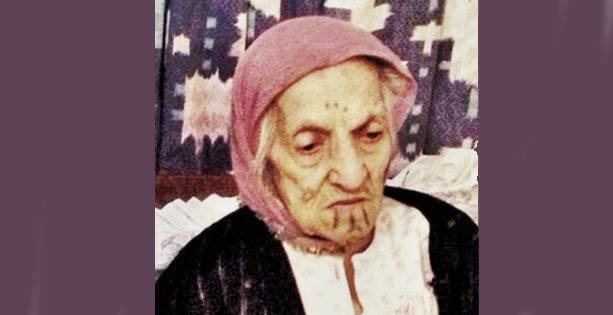Tattoo of an Arab on the face of an Armenian

According to Hayern Aysor, Arab academic Saad Saloumi wrote the following on his Facebook page:
“This woman is over 105. She is the oldest Armenian woman in Iraq, and her memory has carved stories on her face and hands.
Araxi Papazian was 5 years old during the Genocide. Due to forceful deportation, she walked 1,000 miles (May-September 1915), her family members have “fallen” from hunger, diseases and gangs’ attacks one after another. The survivors reached the Syrian desert…
The Armenians would hand their children above the age of eight over to Arab tribes and would tell them about their families so that they would remember and be able to find their relatives again someday.
An Arab man took Araxi, thinking she was a little boy. When he found out that she was a girl, he handed her over to an Arab woman, who keeps her with the other girls.
The Arab mother names her Fatima or Fatuma. Fatima learns how to live like the Arab Bedouins. One day, she decides to tattoo her face like the big girls. When her Arab mother sees the tattoo, she slaps her face and asks her how she dared to pervert her face, telling her she’s an Armenian girl, not an Arab girl who decorates her face with drawings.
The Arab mother wanted to keep Fatima’s face clean and wanted her to follow her religion and preserve her national identity. She refused to see her get married to a Muslim Arab and always said she had to get married to an Armenian man.
A century later, Fatima still remembers her Arab mother and her dialect. She talks about the years that she spent with the Arabs as if it was yesterday. She’s proud of her tattoo and dialect, which goes to show her dual identity.
As you look at Fatima’s photos with her more than 80 children, grandchildren and great-grandchildren today, you think about all the Armenians who could have lived with us or near our borders, if it wasn’t for the Armenian Genocide…Millions of Armenians weren’t born because of a political decision…And the crime continues.
Araxi’s story awakens pain because a similar crime is being perpetrated in Iraq…The Iraqis also dispersed, just like the Armenians did a century ago.
Fatuma’s story awakens in us the “scent” of a lost love and solidarity.
After the Armenian Genocide, Arabs received the Armenians, preserved their women and customs and lived like brothers…”
Saloum concludes with the following: “What curse was it that we saw in this era full of hatred?
May God be with you, Fatuma! Glory to your era, people and the “journey” that you experienced, which sums up these contradicting times.”




 Արևելահայերեն
Արևելահայերեն Արևմտահայերեն
Արևմտահայերեն Русский
Русский







